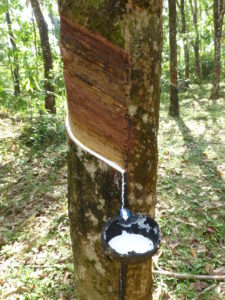Rubber Information: – Rubber is a material with a large variety of properties. Its most important property is elasticity. This property can be utilised for many different purposes, e.g. for seals. Other properties include hardness, flexibility, compressibility, resilience, strength, friction, vibroinsulation, air tightness, water tightness, and resistance to wear, abrasion, chemicals, steam, weather, coldness and heat, as well as electrical nonconductivity and attachability to metals, plastics and textiles. If necessary, the electrical conductivity, flame resistance and other properties can be improved
When we speak about rubber, we may mean three different things:-
• crude rubber (elastomer)
• rubber compound
• finished, vulcanised (cross-linked) rubber product
The basic crude rubber types include natural rubber and various synthetic rubbers. Natural rubber is derived from latex extracted from a gum tree. Synthetic rubber is an industrial product. Its main raw material is oil.
There are several different rubber grades, each with its own special properties. The basic synthetic rubber grades include styrene-butadiene rubbers (SBR), butadiene rubbers (BR), isoprene rubbers (IR), butyl rubbers (IIR), nitrile rubbers (NBR, HNBR, XNBR), epichlorohydrin rubbers (ECO), chloroprene rubbers (CR), urethane rubbers (EU, AU), fluoro rubbers (FPM, FKM), silicone rubbers (Q), chlorosulphinated polyethylene rubbers (CSM), and ethylene-propylene rubbers (EPDM).
Types of Rubber: – There are many types of rubber, each with special properties:
1. Neoprene Rubber
2. Buna-N Rubber
3. Silicone Rubber
4. EPDM Rubber
5. Natural Gum Rubber
6. Viton Rubber
7. Natural Latex Rubber
8. SBR Rubber
9. Vinyl Rubber
10. Santoprene Rubber
11. ECH Rubber
12. Butyl Rubber
13. Latex-Free TPE Rubber
14 Hypalon Rubber
Conditions of Growth:-
Rubber tree (Hevea brasiliensis) is a quick growing tall tree acquiring 20-30 metre height. It begins to yield latex in 5-7 years after planting. It requires hot and humid climate with temperature of 25°-35°C and annual rainfall of over 200 cm. The rainfall should be well distributed throughout the year. Dry spell and low temperatures are harmful. Daily rainfall followed by strong sun is very useful. Deep well drained loamy soils on the hill slopes at elevation ranging from 300 to 450 metres above sea level provide best conditions for its growth. The yields decline at higher elevations and no rubber plantations are found above 700 m elevation.
Rubber
Copyright © 2024
